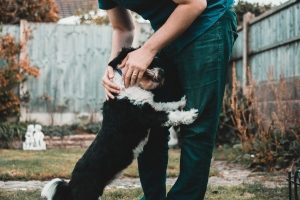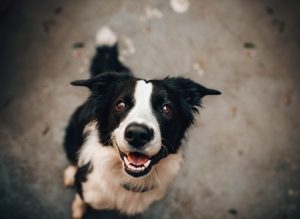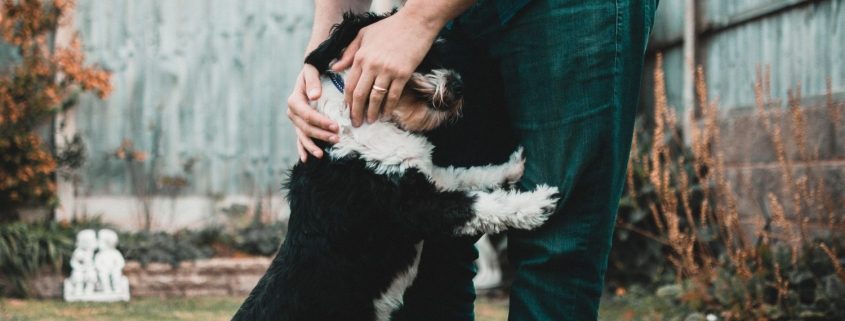Ask Crystal: My Dog Jumps All Over My Guests!
Welcome to “Ask Crystal,” where you can ask your pet behavior questions! You can submit your question for Crystal at the bottom of the page!
Dear Crystal,
My dog gets so excited when people come over to my house. She jumps all over my guests. I tell her no and to get off of them but she still keeps doing it. How can I teach her not to do this? It really embarrasses me!
Sincerely,
Get Down Fido!

Dear Get Down,
Congratulations on having such a friendly dog! It is a good problem to have. Fortunately, this behavior can be changed to something more desirable if we can be consistent about how we set up our dog’s greetings.
Let’s establish why dogs jump on us. Jumping is a greeting behavior and a great way to get attention! Dogs often lick each other’s mouths in greetings; since we are upright they must jump up to reach our mouths. They may also be trying to get closer to your face and smell all the places you have been and what you had for lunch today. They are also very excited to see you, light of their life.
Why does your dog continue to jump on you or your guests when you have clearly and repeatedly told her no? If the motivation of jumping up is attention based, we should ask ourselves what is attention to a dog? Attention to a dog is being looked at, talked to or touched. Even if our intention is to be punishing, it does not mean that our behavior is not actually reinforcing the dog. In fact, the prevalence of dogs jumping up on people would indicate quite the opposite. The typical person’s response to a dog jumping on them is to yell at the dog, “No, bad dog!”, push the dog off and the entire time they are looking at the dog. Just like the naughty child who gets called to the principal’s office daily, negative attention is still attention.
We should always be trying to set our dogs up for success. What that means practically, is before they have been taught new skills, we need to manage their behavior so that they are not practicing the undesirable behavior. It is unrealistic to expect a friendly dog to remain calm in the presence of a new human who smells oh so interesting and new. Management means that when someone comes over to visit and we know the dog does not yet possess the necessary skills, we keep them in a certain area so that they cannot practice the unwanted behavior. Management options in this situation include putting the dog behind a baby gate where they can see the guests but not reach them, having them in a crate or on a tether in the room.
 In regards to the new skills we are going to teach the dog, we need to start out by thinking about what it is that we would like the dog to be doing when they greet people. The majority of people answer that they would like the dog to be sitting. So let’s say that our end goal is that when people approach the dog it sits. Step one is that we teach her how to sit. We are going to be teaching her these skills separately from the super exciting situation. We should start by training her in a low distraction environment when there is very little excitement. Once she knows how to sit we are going to work on pairing the approach of a human as a cue to sit. We will have her on a leash or tether for this part of the training. The purpose of the tether is to prevent her from jumping on people when they approach. It will be easiest to start with people who live with her because usually those people will be less exciting and she is more likely be successful. The person will calmly walk up to the dog. If she looks like she is about to jump up, the person should turn and walk away without saying anything. If she chooses to sit, offer a treat, calm praise and walk away and repeat. At this point we are not petting the dog yet as she will unlikely be able to hold a sit while being petted. If the dog will not offer a sit, you may cue her to sit a few times and then go back to waiting to see if she will offer a sit. Rather than constantly asking the dog to sit when she meets new people, we want her to do the behavior automatically. Start out by reinforcing the sit right away and then as they offer the behavior consistently, wait for them to sit for longer periods before rewarding and then start to build in petting while sitting. Once the dog has had a lot of practice with the family you can start training with willing guests. We want to have her contained and then explain the rules of the game to our guests. Bring the dog out on a leash and hold on to her while your guests practice their approaches. Eventually with enough reinforcement history your dog will offer sitting when people approach her. Consistency is very important when extinguishing an unwanted behavior and installing a new acceptable one.
In regards to the new skills we are going to teach the dog, we need to start out by thinking about what it is that we would like the dog to be doing when they greet people. The majority of people answer that they would like the dog to be sitting. So let’s say that our end goal is that when people approach the dog it sits. Step one is that we teach her how to sit. We are going to be teaching her these skills separately from the super exciting situation. We should start by training her in a low distraction environment when there is very little excitement. Once she knows how to sit we are going to work on pairing the approach of a human as a cue to sit. We will have her on a leash or tether for this part of the training. The purpose of the tether is to prevent her from jumping on people when they approach. It will be easiest to start with people who live with her because usually those people will be less exciting and she is more likely be successful. The person will calmly walk up to the dog. If she looks like she is about to jump up, the person should turn and walk away without saying anything. If she chooses to sit, offer a treat, calm praise and walk away and repeat. At this point we are not petting the dog yet as she will unlikely be able to hold a sit while being petted. If the dog will not offer a sit, you may cue her to sit a few times and then go back to waiting to see if she will offer a sit. Rather than constantly asking the dog to sit when she meets new people, we want her to do the behavior automatically. Start out by reinforcing the sit right away and then as they offer the behavior consistently, wait for them to sit for longer periods before rewarding and then start to build in petting while sitting. Once the dog has had a lot of practice with the family you can start training with willing guests. We want to have her contained and then explain the rules of the game to our guests. Bring the dog out on a leash and hold on to her while your guests practice their approaches. Eventually with enough reinforcement history your dog will offer sitting when people approach her. Consistency is very important when extinguishing an unwanted behavior and installing a new acceptable one.
Until next time,
Crystal







